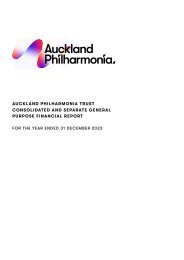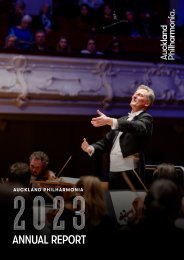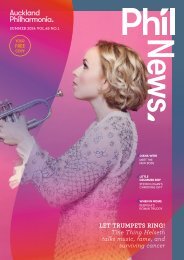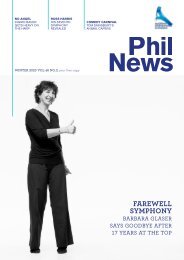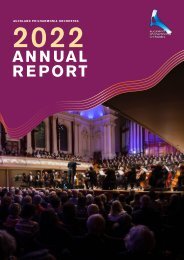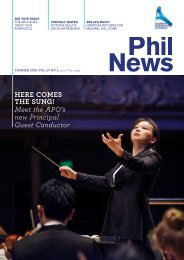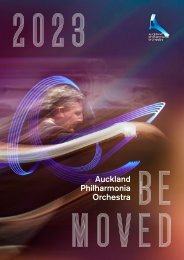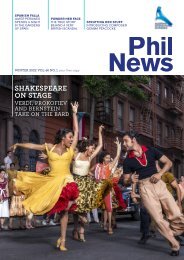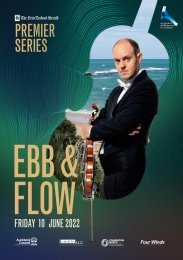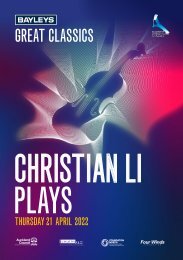You also want an ePaper? Increase the reach of your titles
YUMPU automatically turns print PDFs into web optimized ePapers that Google loves.
assoonist’s great challenges. Similarly, no<br />
timpanist had ever been asked to play music so<br />
virtuosic or violent. There’s great violence in the<br />
harmony, too. Stravinsky had written a famous<br />
passage in Petrushka where the trumpets play<br />
the same tune in two keys at the same time.<br />
And he did this throughout The Rite, smashing<br />
together chords that in normal practice<br />
have nothing whatsoever to do with each<br />
other. Nobody had ever written such nakedly<br />
dissonant music.<br />
Such consistent dissonance can cause<br />
difficulties. Traditional harmonic grammar is<br />
built on a sense of motion, from one chord to<br />
a contrasting one. If chords make less sense<br />
in relation to each other, though, this sense of<br />
musical animation can break down. Stravinsky<br />
solved the problem with rhythm. This is the<br />
single most original feature of the piece, and<br />
it gave him great trouble. He could hear the<br />
passages, he could play them, but he took a<br />
long time to work out how to write them down.<br />
Western art music hitherto had assumed<br />
that rhythm was fundamentally stable. The<br />
dependable one-two-three-four of a march<br />
might slow down or speed up, but the<br />
underlying pulse stayed the same. Stravinsky<br />
shattered this notion. In the final dance, the beat<br />
changes constantly (imagine a speedometer<br />
switching between miles, kilometres or chains<br />
per hour). Even where the beat is stable,<br />
unpredictability reigns. Close to the start, the<br />
strings play a regular pattern of four chords<br />
to the bar. The chords are short; all the beats<br />
seem equally stressed. Except that every now<br />
and then, reinforced by the eight horns, some<br />
chords are casually smacked out with a slashing<br />
accent. Try marching to this:<br />
1 2 3 4, 1 2 3 4, 1 TWO 3 FOUR, 1 2 3 4,<br />
1 TWO 3 4, ONE 2 3 4, ONE 2 3 4,<br />
1 TWO 3 4 …<br />
Stravinsky rewrote the rules of music in<br />
The Rite, but we don’t listen to it because<br />
it’s academically interesting: we listen to it<br />
because it is electrifying. It’s one of the most<br />
exciting, viscerally overpowering experiences<br />
in music. Perhaps unsurprisingly, it was hugely<br />
controversial at first. The premiere notoriously<br />
sparked a riot in the hall. By 1929, however,<br />
Diaghilev could write with immense satisfaction<br />
that “The Times says that The Rite is for the<br />
twentieth century what Beethoven’s Ninth was<br />
for the nineteenth!” And he knew The Rite<br />
hadn’t make solely its composer immortal.<br />
There’s something appropriate that when<br />
Stravinsky died, he was buried, in Venice, a<br />
few plots away from Diaghilev.<br />
NEWSTALK ZB SERIES<br />
PUSHING<br />
BOUNDARIES<br />
8pm, Thur 11 May<br />
Auckland Town Hall<br />
Conductor Rumon Gamba<br />
Cello Torleif Thedéen<br />
Mahler Symphony No.10:<br />
Adagio<br />
Haydn Cello Concerto No.2<br />
Stravinsky The Rite<br />
of Spring<br />
Bookings<br />
ticketmaster.co.nz<br />
or 0800 111 999<br />
apo.co.nz 13



